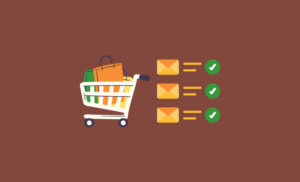Want to learn email marketing deeply? You need to understand the email marketing glossary – the essential terms related to email marketing and automation. That’s why we have compiled a list of the terms of email marketing for you. Read along to learn essential email marketing terms in a single place.
Email marketing remains one of the most powerful tools in a marketer’s arsenal. With the ability to reach a global audience directly in their inbox, it offers unparalleled opportunities for engagement, conversion, and customer retention. However, to leverage the full potential of email marketing, it’s crucial to understand the terminology and best practices that drive successful campaigns.
Whether you’re a seasoned marketer or just starting, this comprehensive glossary of email marketing terms will equip you with the knowledge to create, optimize, and measure your email marketing efforts effectively. Dive in to enhance your strategies and ensure your emails hit the mark every time.
Email Marketing Glossary: Essential Terms You Need to Know

In the dynamic world of email marketing, understanding key terms is essential for executing successful campaigns. Here’s a comprehensive glossary to help you navigate the landscape of email marketing:
A/B Testing
A/B testing compares two versions of an email to determine which one performs better. This involves sending Version A to one half of your email list and Version B to the other half, then comparing metrics like open rates, click-through rates, and conversion rates. This method helps optimize email content, subject lines, send times, and design to enhance overall campaign effectiveness.
Abandoned Cart Email
Abandoned cart emails are automated messages sent to customers who add items to their shopping cart but leave the site without completing the purchase. These emails often include reminders of the items left behind and incentives like discounts or free shipping to encourage the customer to complete their purchase, making them highly effective in recovering potentially lost sales.
Above the Fold
“Above the fold” refers to the portion of an email visible without scrolling when the email is first opened. Placing critical information, such as the main message and call to action, above the fold increases the likelihood that recipients will engage with the email immediately.
Anti-Spam Laws
Anti-spam laws are regulations designed to protect individuals from receiving unsolicited emails. These laws, such as the CAN-SPAM Act of 2003 in the United States, set commercial email rules, establish commercial message requirements, give recipients the right to stop emails, and spell out tough penalties for violations. Different countries and regions have specific anti-spam laws, so marketers need to understand and comply with the relevant laws in their target markets to avoid legal issues and maintain good email deliverability.
Autoresponder
An autoresponder is an automated email response triggered by specific actions taken by a subscriber, such as signing up for a newsletter or making a purchase. Autoresponders can be used to welcome new subscribers, provide order confirmations, deliver lead magnets, or follow up with customers post-purchase to request feedback or suggest related products.
Bounce Rate
The bounce rate is the percentage of emails that are not successfully delivered to recipients’ inboxes. Bounces are classified into two types: hard bounces (permanent delivery failures due to reasons like invalid email addresses) and soft bounces (temporary issues like full inboxes or server problems). Monitoring bounce rates helps maintain a clean email list and ensures better deliverability.
Bulk Email
Bulk email is the act of sending one email campaign to a large group at once. Marketing messages, newsletters, updates, coupons, and invitations typically comprise bulk emails.
Call to Action (CTA)
A call to action (CTA) in an email encourages the reader to take a specific action. Effective CTAs are clear, concise, and compelling, directing the reader towards a desired outcome such as clicking a link, making a purchase, downloading a resource, or filling out a form. The design, placement, and wording of CTAs can significantly impact their effectiveness.
Campaign
A campaign is a coordinated set of email messages sent to a specific audience over a defined period. Each campaign typically has a single overarching goal, such as promoting a product launch, announcing a sale, or nurturing leads through a series of educational emails. Effective campaigns are well-planned, targeted, and measure their success through key performance indicators (KPIs).
CAN-SPAM Act
The CAN-SPAM Act, signed into law in 2003, establishes national standards for sending commercial email marketing campaigns in the United States. Enforced by the Federal Trade Commission (FTC), it focuses on unsubscribe compliance, content compliance, and sending behavior compliance. Key requirements include honoring opt-out requests within 10 days and maintaining a functional unsubscribe mechanism for at least 30 days after sending the email. This law aims to protect consumers from unsolicited and misleading emails while ensuring transparency and accountability from marketers.
Click-Through Rate (CTR)
The click-through rate (CTR) is the percentage of email recipients who clicked on one or more links contained in an email. CTR is a crucial metric for measuring engagement and the effectiveness of email content. High CTRs indicate that the email content is relevant and compelling to the audience, while low CTRs may signal a need for improvement in email design, copy, or targeting.
Conversion Rate
The conversion rate is the percentage of email recipients who completed a desired action, such as making a purchase, signing up for a webinar, or downloading a whitepaper, as a result of receiving an email. Conversion rates directly measure an email campaign’s effectiveness in achieving its goals and can be influenced by factors such as the offer’s attractiveness, the clarity of the CTA, and the relevance of the email to the recipient.
Deliverability
Deliverability is the ability of an email to reach the recipient’s inbox without being blocked or diverted to the spam folder. Factors affecting deliverability include the sender’s reputation, email content, authentication practices (like SPF, DKIM, and DMARC), and recipient engagement. High deliverability rates are crucial for ensuring that your messages reach your audience and achieve their intended impact.
DKIM (DomainKeys Identified Mail)
DKIM is an email authentication protocol that allows the receiver to check that an email was indeed sent and authorized by the owner of that domain. It works by affixing a digital signature to the email’s header, which is verified by the recipient’s mail server. This verification helps prevent email spoofing and ensures the integrity of the message, making it a crucial component in maintaining email security and trustworthiness.
DMARC (Domain-based Message Authentication, Reporting, and Conformance)
DMARC is an email authentication protocol designed to give email domain owners the ability to protect their domain from unauthorized use. It helps verify that emails are properly authenticated against established DKIM and SPF standards and provides a way for email senders and receivers to report on email authenticity. By implementing DMARC, domain owners can prevent email spoofing and phishing attacks, enhancing overall email security and trustworthiness.
Domain Reputation
Domain reputation refers to how email services and spam filters perceive your domain based on your sending practices. A positive reputation ensures your emails are delivered to recipients’ inboxes, while a negative reputation can result in emails being marked as spam or blocked. Factors influencing domain reputation include sending volume, email engagement rates, and complaint rates. Maintaining a good domain reputation is crucial for successful email marketing campaigns.
Double Opt-In
Double opt-in is a subscription method where a user must confirm their email address by clicking a link in a confirmation email before being added to the email list. This process ensures that the email address is valid and that the subscriber genuinely wants to receive emails from you, helping to maintain a high-quality email list and reducing the risk of spam complaints.
Drip Campaign
A drip campaign is a series of automated emails sent to subscribers over a specific period, often based on their behavior or a predefined schedule. Drip campaigns are used for lead nurturing, onboarding new customers, re-engaging inactive subscribers, and providing ongoing education or content. Each email in the sequence builds on the previous one, guiding the recipient through a predetermined path.
Dynamic Content
Dynamic content in an email changes based on the recipient’s preferences, behaviors, or demographic information. Dynamic content allows for personalized and relevant messaging, enhancing the recipient’s experience and increasing engagement. Examples include product recommendations based on past purchases, personalized greetings, and tailored offers.
Email Automation
Email automation involves sending emails to subscribers based on specific triggers or schedules. This approach enhances marketing efficiency by delivering timely, relevant messages. Common uses include nurturing leads through a series of emails, sending personalized birthday messages, or updating subscribers on new blog posts. Automated emails help maintain engagement, generate leads, and boost sales by providing consistent and personalized communication without requiring manual effort.
Email Authentication
Email authentication is a process used to verify the legitimacy of an email message, ensuring it comes from the claimed sender and has not been altered during transit. It involves implementing protocols such as SPF (Sender Policy Framework), DKIM (DomainKeys Identified Mail), and DMARC (Domain-based Message Authentication, Reporting & Conformance) to protect against email-based threats like phishing, spoofing, and spam. These methods work together to confirm the sender’s identity, maintain the integrity of the email content, and provide policies for handling unauthenticated messages, thereby enhancing email security and building trust with recipients.
Email Deliverability
Email deliverability is the ability to ensure that your emails reach subscribers’ inboxes rather than being marked as spam or bouncing back. Factors affecting deliverability include authentication practices (like SPF and DKIM), list hygiene, engagement rates, and the sender’s reputation. High deliverability means emails are more likely to be seen and engaged with by recipients. Common practices to improve deliverability include using double opt-in, maintaining a clean email list, avoiding spammy content, and making it easy for subscribers to opt-out if they choose.
Email Marketing Template
An email marketing template is a pre-made layout that serves as a starting point for email campaigns. These templates allow marketers to design emails without needing to start from scratch, providing a framework that includes placeholders for images, text, and other elements. They can be customized with colors, fonts, branding, and content to fit the specific needs of the campaign. Templates help ensure consistency and save time, especially for recurring email types like newsletters, promotions, and announcements.
Email Preheader
An email preheader is the summary text that follows the subject line when viewed in an inbox. This snippet provides a brief preview of the email’s content, often working alongside the subject line to entice recipients to open the email. Effective preheader text can significantly improve open rates by offering additional context or highlighting key information. It’s important to keep preheader text concise, typically between 40 and 130 characters, to ensure it displays properly across different email clients and devices.
Hard Bounce
A hard bounce is an email that cannot be delivered due to a permanent issue, such as an invalid email address, a non-existent domain, or a blocked server. Hard bounces should be removed from your email list immediately to maintain a healthy sender reputation and improve overall deliverability.
HTML Email
An HTML email includes HTML code, allowing for the use of images, colors, and various fonts, making the email more visually appealing compared to plain text emails. HTML emails can include rich media elements, such as videos and GIFs, and are often used for promotional purposes. However, they must be designed with responsiveness and accessibility in mind.
List Hygiene
List hygiene involves maintaining a clean and updated email subscriber list. This practice includes honoring unsubscribe requests, removing email addresses that frequently bounce, and conducting re-engagement campaigns to identify and remove inactive subscribers. Regular list hygiene helps improve email deliverability, engagement rates, and overall campaign effectiveness by ensuring that emails are sent to interested and active recipients.
List Segmentation
List segmentation is the practice of dividing an email list into smaller groups based on specific criteria, such as demographics, purchase history, engagement level, or preferences. Segmentation allows for more targeted and relevant email campaigns, resulting in higher engagement rates and better overall performance. Examples include segmenting by location, past purchase behavior, or email interaction history.
Open Rate
The open rate is the percentage of emails that were opened by recipients out of the total number of emails sent. Open rates are influenced by factors such as the subject line, sender name, and send time. High open rates indicate that the email subject line and sender reputation resonate with the audience, while low open rates may suggest the need for optimization.
Personalization
Personalization is the practice of using a recipient’s personal information, such as their name, purchase history, or browsing behavior, to tailor the content of an email to their preferences and behavior. Personalization can significantly improve engagement and conversion rates by making emails more relevant and appealing to the recipient. Examples include personalized greetings, product recommendations, and tailored offers.
Plain Text Email
A plain text email contains only text, with no HTML or images. Plain text emails are often used for more personal or straightforward messages, such as transactional emails or quick updates. They are generally less likely to be flagged as spam and can be more accessible to recipients with visual impairments or those using text-only email clients.
Recipient
An email recipient is an individual who has opted in to receive emails from a business or individual. This often involves signing up through a website to receive information, alerts, and updates. Businesses need to ensure they comply with anti-spam laws when sending emails to recipients, maintaining trust and legal standards in their communications.
Responsive Design
Responsive design ensures that email content adapts to various screen sizes and devices, ensuring the email looks good and is easy to read on smartphones, tablets, and desktops. Responsive design is crucial for providing a positive user experience, as a significant portion of email opens occur on mobile devices. Techniques include using flexible layouts, scalable images, and legible fonts.
Segmentation
Segmentation is the division of email subscribers into smaller segments based on set criteria, such as geographic location, interests, or purchase history. This practice enables marketers to deliver more relevant and personalized email content to each segment, improving engagement and reducing unsubscribe rates. Common segmentation strategies include geographic segmentation, behavior-specific segmentation, and content-specific segmentation. By tailoring messages to specific segments, marketers can enhance the effectiveness of their email campaigns and better meet the needs of their audience.
SMTP (Simple Mail Transfer Protocol)
SMTP is the standard protocol used for sending email messages across networks. It facilitates the transmission of emails from the sender’s server to the recipient’s server. SMTP is essential for the delivery of emails, ensuring messages are routed correctly to their destinations. It works in conjunction with other protocols like IMAP or POP3, which are used to retrieve emails from a server.
Soft Bounce
A soft bounce is an email that cannot be delivered due to a temporary issue, such as a full inbox, a server problem, or a message too large to be delivered. Soft bounces may be retried later, and repeated soft bounces can eventually lead to a hard bounce. Monitoring soft bounces helps identify potential issues with email content or sending practices.
Spam
Spam refers to unsolicited and often irrelevant or inappropriate emails sent to a large number of recipients, typically for advertising purposes. Spam can damage your sender’s reputation and result in emails being blocked or filtered into spam folders. To avoid being marked as spam, ensure that your emails comply with anti-spam laws, such as CAN-SPAM and GDPR, and focus on delivering relevant, valuable content to subscribers.
Subject Line
A subject line is the email’s title and often the first thing a recipient sees. A compelling subject line can significantly impact open rates by capturing the recipient’s attention and enticing them to open the email. Effective subject lines are clear, concise, and relevant, often using personalization, urgency, or curiosity to drive engagement.
Transactional Email
A transactional email is an automated email triggered by a specific user action, such as a purchase or a password reset request. These emails include essential information related to the transaction, like receipts, shipping confirmations, or account updates. Transactional emails typically have higher open rates than marketing emails due to their relevance and timeliness. They can also be customized to reflect the brand’s voice and personality, enhancing the user experience and reinforcing brand identity.
Unsubscribe Rate
The unsubscribe rate is the percentage of email recipients who opt out of receiving future emails from a sender. A high unsubscribe rate can indicate issues with email relevance, frequency, or content quality. Monitoring unsubscribe rates helps identify areas for improvement and ensures compliance with anti-spam regulations by respecting recipients’ preferences.
Whitelist
A whitelist is a list of approved email addresses or domains that are allowed to send emails to a recipient’s inbox, reducing the chances of emails being marked as spam. Encouraging subscribers to add your email address to their whitelist can improve deliverability and ensure that your emails reach their intended audience.
Understanding these terms will equip you with the knowledge needed to optimize your email marketing strategies, ensuring that your campaigns are effective, compliant, and engaging. If you are looking to customize your WooCommerce emails, learn our guide on how to customize WooCommerce emails easily. This email marketing glossary is intended to help you understand email marketing better and achieve your email marketing goals easily.



